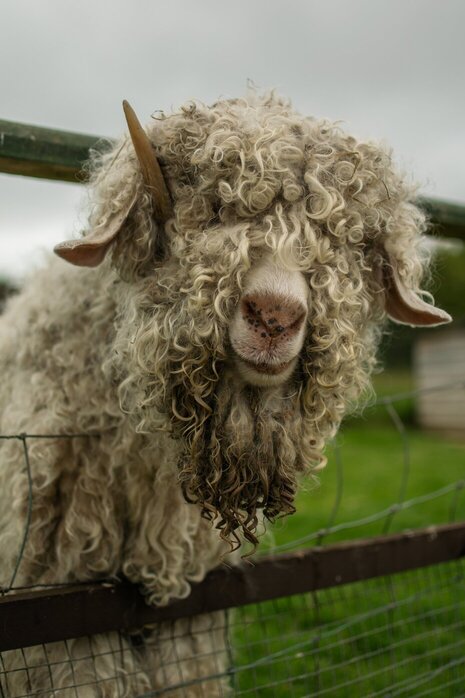Angora goat has been since early biblical history and it originated from Angora in Asia Minor. The use of mohair was talked about in the days of Moses thus the Angora would be sometime between 1571 and 1451 BC.
This is according to the Angora Goat Mohair Industry publication from USDA (Miscellaneous Bulletin 50, 1929). In the early 19th century, Mohair was a valuable commercial product.
The Turks crossed the Angora goat with popular stock to increase the poundage of salable hair. Thus increasing the supply of mohair accessible for exportation to European countries.
This happened probably because there was no effort to keep the original Angora separate, and the general rise in size and strength of the goats available in the Angora area was, undoubtedly, somewhat the outcome of this mix with other blood.
The Angora stock was circulated to different countries, and a couple of Angoras were introduced to Europe by Charles V in 1554.
Then in 1765, the Spanish government imported the breed and 20years later, a significant number were imported into France.
Despite this, none of the imports was a success in the establishment of mohair production.
Instead in 1838, Angoras were moved to South Africa, with subsequent importations, the mohair production was fully established in the country.
This made South Africa one of the three leading mohair-producing economies in the world after the United States and Turkey.
Angora Goat for Mohair Production
The value of the mohair that is clipped from the Angora makes it more valuable when compared to other goats.
The regular goat found in the U.S. is generally sheared twice a year and produces roughly 5.3 pounds of mohair per shearing and fibre having a basic length of about 12 and 15cm.
Mohair and wool share similar chemical composition but are different because it has a smoother surface and is very thin.
But the mohair does not have the felting abilities of wool.
Rather, Mohair can be compared to rough wool in the size of fibre. It is an elastic and solid fibre, with a substantial gleam, and can be dyed.
It is highly valued as furnishing material for the production of plushest and several other covering materials if beauty, strength, and durability are to be considered.
Though the market value of mohair varies unlike wool, but then, the overall, prices obtained for the clip is satisfactory.
In bad economic times, fine hair was favourable but because this fine hair is usually clipped from the young goats, sorting for fertility is of great importance.
Characteristics of Angora Goat
1) This breed is very attractive and both sexes are horned.
2) The bucks have a distinct spiral to the horn, which faces back and away from the head; at times the horns are up to two or more feet long.
3) On the other hand, the female horn is much smaller, reasonably short, and has little possibility to spiral.
4) The female horn rarely goes beyond 9 or 10 inches. Their ears are usually weighty and sagging.
5) They are small in size when compared to other animals like milk goats, sheep, or common goats.
6) There is a significant difference in the size of the goats, nevertheless, mature bucks usually weigh between 180 to 225 pounds but do not attain their maximum weight till after five years old. While the mature Does will weigh between 70 to 110 pounds.
7) The goat looks like a sheep, but the beef features are less developed.
8) It has a straight back, with the rib well skipped, and the body is equal in depth.
9) The chest area is wide. They have straight legs, with an amply developed rear area.
Ringlet and Flat Lock Hair
Present-day Angoras are usually grouped by the way their hair grows either as lock hair or ringlet.
Ringlet hair type goats are usually called the C Type goats, while those with flat mohair locks are referred to as B type goats.
For the ringlet type goats, their mohair is in constricted ringlets almost all through its full length and is the finest mohair made. On the other hand, the flatlock is generally curly and bulkier in its form.
A Valuable Foraging Animal
The Angora is adaptable to certain agricultural units due to its unique grazing has grazing pattern.
Goats consume a lot of “browse” and have an inclination to eat as high as their hind legs can carry them standing. This gives goats an edge in areas sheep would not perform well.
Shortcomings of the Angora goat
The Angora breed is not as productive as the other goats and twin births are not common.
Normally, goats in large range bands kids from between 60% to 70%, but in well-managed small bands of pedigree goats the degree of reproduction may be a little over 100%.
It is one of the most delicate domestic animals and is prone to harm from inner parasites than are sheep.
At birth, they are really delicate, and the young ones require some form of protection (especially if the weather is cold) through their first few days.
Even though the mature goat is known to be a strong animal when in full body hair, it cannot tolerate cold weather especially after it has been sheared.
That is why there is always a significant record of losses after storms in Angora flocks and at kidding and shearing periods.
Meat Production
Over the years, goat remains have been sold as inferior sheep remains. Angora goat rearers, have however supported an effort to have the Angora goat carcass called “chevon’ and sold per se on the market.
The flesh is fairly satisfactory, mostly from young goats in a good state, and people talk about it as a kind of food.
The bodies are typically thinner fleshed and the dressing qualities are similarly lower than that of sheep that have been fed alike.
Featured image
- By Jessica Burnett on Unsplash


